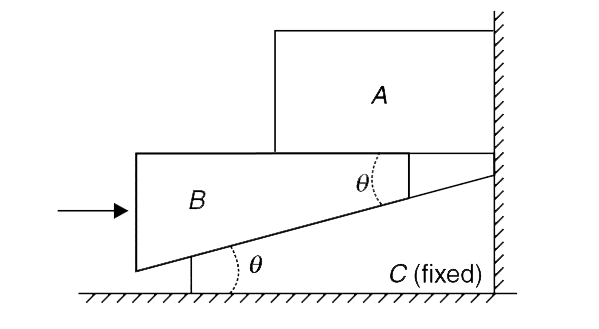In order to lift a heavy block A, an engineer has designed a wedge system as shown. Wedge C is fixed. A horizontal force F is applied to B to lift block A. Wedge B itself has negligible mass and mass of A is M. The coefficient of friction at all surfaces is μ. Find the value of applied force F at which the block A just begins to rise.

The correct Answer is:F=Mg1−μ2[μ+μcosθ+sinθcosθ−μsinθ]
Step by step video, text & image solution for In order to lift a heavy block A, an engineer has designed a wedge system as shown. Wedge C is fixed. A horizontal force F is applied to B to lift block A. Wedge B itself has negligible mass and mass of A is M. The coefficient of friction at all surfaces is mu. Find the value of applied force F at which the block A just begins to rise. by Physics experts to help you in doubts & scoring excellent marks in Class 11 exams.
Updated on:21/07/2023Topper's Solved these Questions
Similar Questions
A particle is acted upon by a force for 1 second whose X component remains constant at Fx=30N but y and z components vary with time as shown in the graph. Calculate the magnitude of change in momentum of the particle in 1 s. What angle does the change in momentum (Δ→P) make with X axis ?

View SolutionThe pulley of radius R can rotate freely about its axle as shown in the figure. A thread is tightly wrapped around the pulley and its free end carries a block of mass m. When the block is at a height h above the ground the system is released (i.e., the pulley is made free to rotate & the block is allowed to fall) and at the same instant the axle is moved up keeping it horizontal all the time. When the block hits the floor the axle has gone up by a distance 2h. Find the angle by which the pulley must have rotated by this time.

View SolutionIn the adjoining figure, the coefficient of friction between wedge (of mass M) and block (of mass m) is μ.
Find the minimum horizontal force F required to keep the block stationary with respect to wedge.

View SolutionThe coefficient of friction between the block A of mass m and the triangular wedge B of mass M is μ. There in no friction between the wedge and the plane if the system (block A+ wedge B) is released so that there is no stiding between A and B find the inclination θ

View SolutionIn figuer, shown all the surfaces are frictionless, and mass of the block is m=100g . The block and the wedge are held initially at rest. Now the wedge is given a horizontal acceleration of 10ms^-2 by applying a force on the wedge, so that the block does not slip on the wedge. Then find the work done in joules by the normal force in ground frame on the block in 1s .
View SolutionA block of mass m lies on wedge of mass M , which lies on fixed horizontal surface. The wedge is free to move on the horizontal surface. A horizontal force of magnitude F is applied on block as shown neglecting friction at all surface, the value of force F such that block has no relative motion w.r.t wedge will be: (Where g is acceleration due to gravity)

View SolutionA block of mass m is placed on a smooth wedge of inclination. The whole system is accelerated horizontally so that block does not slip on the wedge Find the i) Acceleration of the wedge Force to be applied on the wedge Force exerted by the wedge on the block .
View SolutionWedge is fixed on horizontal surface. Block A is pulled upward by applying a force F as shown in figure and there is no friction between the wedge and the block A while coefficient of friction between A and B is mu . If there is no relative motion between the block A and B then frictional force developed between A and B is
View SolutionIn the arrangement shown in figure, a block A of mass m has been placed on a smooth wedge B of mass M. The wedge lies on a horizontal smooth surface. Another block C of mass M4 has been placed in contact with the wedge B as shown. The coefficient of friction between the block C and the vertical wedge wall is μ=34. Find the ratio mM for which the block C will not slide with respect to the wedge after the system is released?

View SolutionA wedge of mass M makes an angle θ with the horizontal. The wedge is placed on horizontal frictionless surface. A small block of mass m is placed on the inclined surface of wedge. What horizontal force F must be applied to the wedge so that the force of friction between the block and wedge is zero ?
View SolutionA wedge with mass M rests on a frictionless horizontal surface A block with mass m is placed on the wedge. There is no friction between the block and the wedge. A horizontal force f is applied to the wedge. What magnitude F must have if the block is to remain at constant height above the table top?

View SolutionA block of mass 2 kg is kept on a smooth wedge of mass 3 kg and wedge is kept on a rough horizontal surface. A vertical force of 60 N is applied on the minimum coefficient of friction between the wedge and horizontal surface, so that wedge remains at rest during the motion of block on the wedge ?
View SolutionIn the adjoining figure, the coefficient of friction between wedge ( of mass M) and block ( of mass m) is μ.
Find the minimum horizontal force F rquired to keep the block stationary with respect to wedge

View SolutionCoefficient of friction between block of mass m and fixed wedge is mu = 0.5 . For what value of (m)/(M) frictional force between block of mass m and wedge becomes zero ?
View SolutionA block of mass m is lying on horizontal surface of coefficient of friction mu. A force is applied to the block at an angle theta with the horizontal. The block will move with a minimum force F if
View Solution

